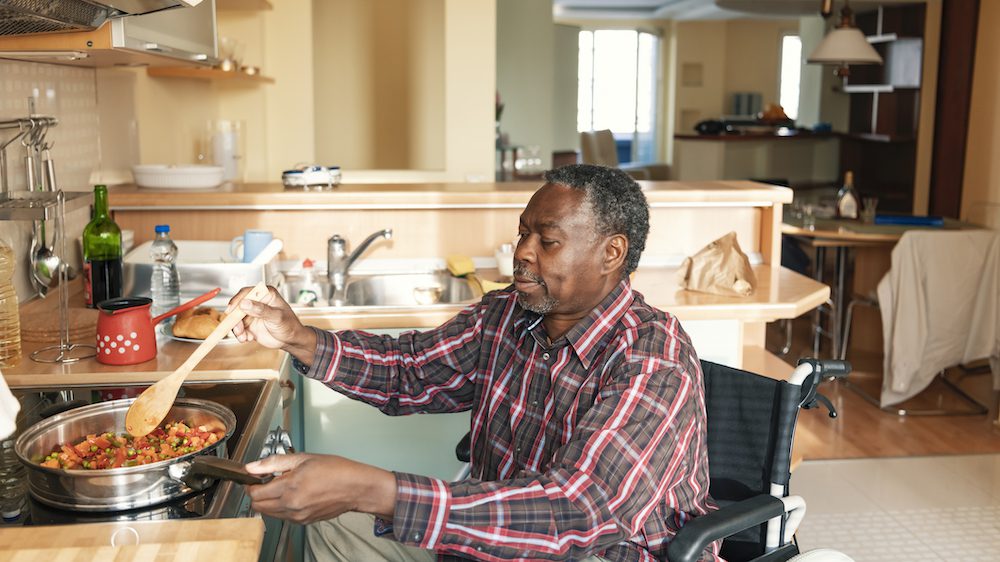
RealPeopleGroup/Getty Imaages
Creating a safe, accessible, and comfortable living environment is something everyone can relate to these days, whether it’s having a convenient work-from-home station or finding cost-efficient ways to stay cool indoors. But life during a pandemic has also shed light on the realities of growing old in one’s own home.
“People who have lived in their homes for decades find comfort in memories and familiarity. Moving to a new space might cause distress or emotional turmoil, as it often involves learning new patterns and purging belongings,” says Alessandra Wood, vice president of online interior design at Modsy.
And since many of the early outbreaks of COVID-19 took place in assisted-living facilities, it may be safer in one sense to continue living at home—but that will require changes. Those may include downsizing, relocating to a single-level home, or renovating an existing house. If aging in place might be of interest for you or a loved one, here are some tips on how to prepare a home.
Design for safety
Aim for an open floor plan with as little obstruction as possible.
“Be sure layouts, furniture placement, and doorways allow ample room to walk around the space or use wheelchairs and walkers when necessary,” says Wood.
If a home has stairs, Wood recommends installing a chairlift to reduce the possibility of falls. Area rugs can be tripping hazards, so consider removing them.
And be sure corners and edges are not jutting out.
“Eliminate pointed edges, such as on coffee tables, dining tables, or beds, where possible as these can be hazardous when bumped into,” Wood says.
Design for accessibility

Serghei Starus/Getty Images
Making the home environment more accessible can make day-to-day living easier.
Designing for accessibility can include installing cabinet drawers, which reduce the amount of bending and reaching required by the homeowner, says Bryson Cook, design expert and Miami showroom manager for Scavolini.
“In kitchens, we like shallow drawers for accessories like utensils, and deeper drawers for pots, pans, and Tupperware. Drawers, combined with inventive organizers, can also be used in place of regular cabinetry for dish and flatware storage,” says Cook. “In bathrooms, drawers incorporated into vanities and other storage can enhance accessibility.”
He says it’s not a bad idea to equip drawers with a servo drive system, which opens the drawers with a simple touch, and adding an LED strip with a sensor makes it easier to see what’s inside.
Cook also thinks a kitchen wall oven is a nice addition, especially if built into a tall cabinet to make it more ergonomic.
“It allows you to load and unload oven contents without having to bend over. There are some new oven options that even open sideways so that you do not have to lift a heavy door,” says Cook.
Design for convenience
Another tenet of aging in place is having things at a comfortable height or level. Lowered countertops can allow one to perform tasks like cooking or washing dishes while sitting comfortably.
“Upper cabinets with pull-down shelving also enable access to anything that is needed for cooking and can be very stylish and efficient,” says Cook.
He also suggests storing the most-used small appliances at counter height for easy access.
Design for simplicity
Any addition of technology can really simplify everyday tasks in the home, and part of aging in place is embracing gadgets that can make our lives easier.
“Devices such as smart bulbs allow for lights to go on and off with speech commands. The Nest Thermostat senses your temperature preferences based on your usage and can be easily controlled from afar,” says Wood.
Touch-activated faucets and lamps are worth integrating into your home. And here’s one more to consider: push-to-open appliances.
“With a light push, you can open your fridge, freezer, ovens, and other appliances with minimal effort,” says Cook.
The post Why Aging in Place at Home Matters Now More Than Ever appeared first on Real Estate News & Insights | realtor.com®.
No comments:
Post a Comment